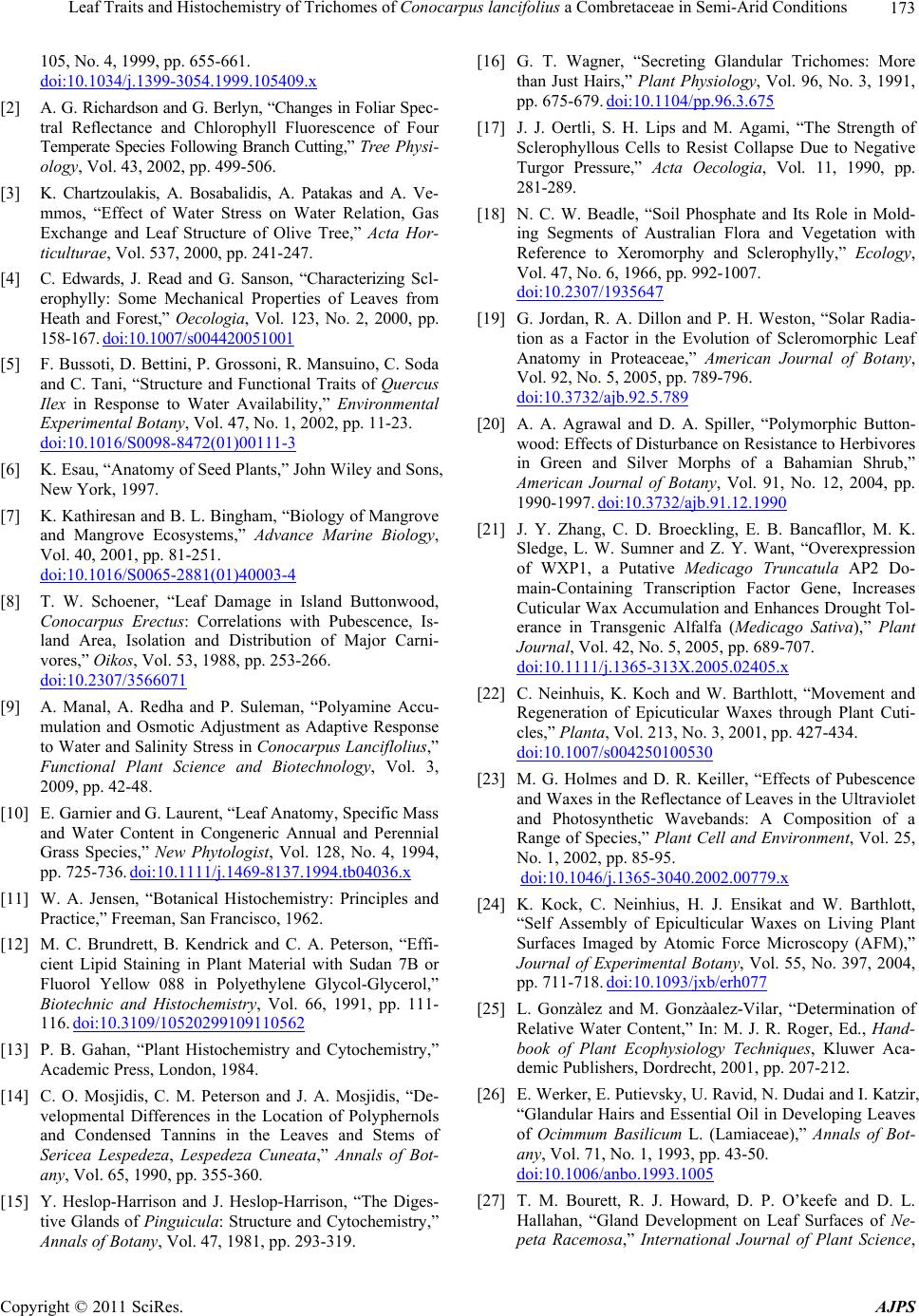
Leaf Traits and Histochemistry of Trichomes of Conocarpus lancifolius a Combretaceae in Semi-Arid Conditions173
105, No. 4, 1999, pp. 655-661.
doi:10.1034/j.1399-3054.1999.105409.x
[2] A. G. Richardson and G. Berlyn, “Changes in Foliar Spec-
tral Reflectance and Chlorophyll Fluorescence of Four
Temperate Species Following Branch Cutting,” Tree Physi-
ology, Vol. 43, 2002, pp. 499-506.
[3] K. Chartzoulakis, A. Bosabalidis, A. Patakas and A. Ve-
mmos, “Effect of Water Stress on Water Relation, Gas
Exchange and Leaf Structure of Olive Tree,” Acta Hor-
ticulturae, Vol. 537, 2000, pp. 241-247.
[4] C. Edwards, J. Read and G. Sanson, “Characterizing Scl-
erophylly: Some Mechanical Properties of Leaves from
Heath and Forest,” Oecologia, Vol. 123, No. 2, 2000, pp.
158-167. doi:10.1007/s004420051001
[5] F. Bussoti, D. Bettini, P. Grossoni, R. Mansuino, C. Soda
and C. Tani, “Structure and Functional Traits of Quercus
Ilex in Response to Water Availability,” Environmental
Experimental Botany, Vol. 47, No. 1, 2002, pp. 11-23.
doi:10.1016/S0098-8472(01)00111-3
[6] K. Esau, “Anatomy of Seed Plants,” John Wiley and Sons,
New York, 1997.
[7] K. Kathiresan and B. L. Bingham, “Biology of Mangrove
and Mangrove Ecosystems,” Advance Marine Biology,
Vol. 40, 2001, pp. 81-251.
doi:10.1016/S0065-2881(01)40003-4
[8] T. W. Schoener, “Leaf Damage in Island Buttonwood,
Conocarpus Erectus: Correlations with Pubescence, Is-
land Area, Isolation and Distribution of Major Carni-
vores,” Oikos, Vol. 53, 1988, pp. 253-266.
doi:10.2307/3566071
[9] A. Manal, A. Redha and P. Suleman, “Polyamine Accu-
mulation and Osmotic Adjustment as Adaptive Response
to Water and Salinity Stress in Conocarpus Lanciflolius,”
Functional Plant Science and Biotechnology, Vol. 3,
2009, pp. 42-48.
[10] E. Garnier and G. Laurent, “Leaf Anatomy, Specific Mass
and Water Content in Congeneric Annual and Perennial
Grass Species,” New Phytologist, Vol. 128, No. 4, 1994,
pp. 725-736. doi:10.1111/j.1469-8137.1994.tb04036.x
[11] W. A. Jensen, “Botanical Histochemistry: Principles and
Practice,” Freeman, San Francisco, 1962.
[12] M. C. Brundrett, B. Kendrick and C. A. Peterson, “Effi-
cient Lipid Staining in Plant Material with Sudan 7B or
Fluorol Yellow 088 in Polyethylene Glycol-Glycerol,”
Biotechnic and Histochemistry, Vol. 66, 1991, pp. 111-
116. doi:10.3109/10520299109110562
[13] P. B. Gahan, “Plant Histochemistry and Cytochemistry,”
Academic Press, London, 1984.
[14] C. O. Mosjidis, C. M. Peterson and J. A. Mosjidis, “De-
velopmental Differences in the Location of Polyphernols
and Condensed Tannins in the Leaves and Stems of
Sericea Lespedeza, Lespedeza Cuneata,” Annals of Bot-
any, Vol. 65, 1990, pp. 355-360.
[15] Y. Heslop-Harrison and J. Heslop-Harrison, “The Diges-
tive Glands of Pinguicula: Structure and Cytochemistry,”
Annals of Botany, Vol. 47, 1981, pp. 293-319.
[16] G. T. Wagner, “Secreting Glandular Trichomes: More
than Just Hairs,” Plant Physiology, Vol. 96, No. 3, 1991,
pp. 675-679. doi:10.1104/pp.96.3.675
[17] J. J. Oertli, S. H. Lips and M. Agami, “The Strength of
Sclerophyllous Cells to Resist Collapse Due to Negative
Turgor Pressure,” Acta Oecologia, Vol. 11, 1990, pp.
281-289.
[18] N. C. W. Beadle, “Soil Phosphate and Its Role in Mold-
ing Segments of Australian Flora and Vegetation with
Reference to Xeromorphy and Sclerophylly,” Ecology,
Vol. 47, No. 6, 1966, pp. 992-1007.
doi:10.2307/1935647
[19] G. Jordan, R. A. Dillon and P. H. Weston, “Solar Radia-
tion as a Factor in the Evolution of Scleromorphic Leaf
Anatomy in Proteaceae,” American Journal of Botany,
Vol. 92, No. 5, 2005, pp. 789-796.
doi:10.3732/ajb.92.5.789
[20] A. A. Agrawal and D. A. Spiller, “Polymorphic Button-
wood: Effects of Disturbance on Resistance to Herbivores
in Green and Silver Morphs of a Bahamian Shrub,”
American Journal of Botany, Vol. 91, No. 12, 2004, pp.
1990-1997. doi:10.3732/ajb.91.12.1990
[21] J. Y. Zhang, C. D. Broeckling, E. B. Bancafllor, M. K.
Sledge, L. W. Sumner and Z. Y. Want, “Overexpression
of WXP1, a Putative Medicago Truncatula AP2 Do-
main-Containing Transcription Factor Gene, Increases
Cuticular Wax Accumulation and Enhances Drought Tol-
erance in Transgenic Alfalfa (Medicago Sativa),” Plant
Journal, Vol. 42, No. 5, 2005, pp. 689-707.
doi:10.1111/j.1365-313X.2005.02405.x
[22] C. Neinhuis, K. Koch and W. Barthlott, “Movement and
Regeneration of Epicuticular Waxes through Plant Cuti-
cles,” Planta, Vol. 213, No. 3, 2001, pp. 427-434.
doi:10.1007/s004250100530
[23] M. G. Holmes and D. R. Keiller, “Effects of Pubescence
and Waxes in the Reflectance of Leaves in the Ultraviolet
and Photosynthetic Wavebands: A Composition of a
Range of Species,” Plant Cell and Environment, Vol. 25,
No. 1, 2002, pp. 85-95.
doi:10.1046/j.1365-3040.2002.00779.x
[24] K. Kock, C. Neinhius, H. J. Ensikat and W. Barthlott,
“Self Assembly of Epiculticular Waxes on Living Plant
Surfaces Imaged by Atomic Force Microscopy (AFM),”
Journal of Experimental Botany, Vol. 55, No. 397, 2004,
pp. 711-718. doi:10.1093/jxb/erh077
[25] L. Gonzàlez and M. Gonzàalez-Vilar, “Determination of
Relative Water Content,” In: M. J. R. Roger, Ed., Hand-
book of Plant Ecophysiology Techniques, Kluwer Aca-
demic Publishers, Dordrecht, 2001, pp. 207-212.
[26] E. Werker, E. Putievsky, U. Ravid, N. Dudai and I. Katzir,
“Glandular Hairs and Essential Oil in Developing Leaves
of Ocimmum Basilicum L. (Lamiaceae),” Annals of Bot-
any, Vol. 71, No. 1, 1993, pp. 43-50.
doi:10.1006/anbo.1993.1005
[27] T. M. Bourett, R. J. Howard, D. P. O’keefe and D. L.
Hallahan, “Gland Development on Leaf Surfaces of Ne-
peta Racemosa,” International Journal of Plant Science,
Copyright © 2011 SciRes. AJPS